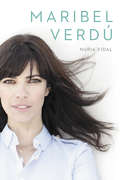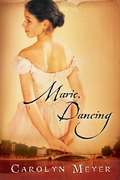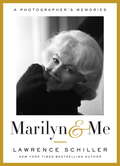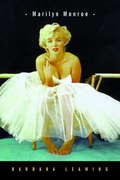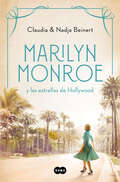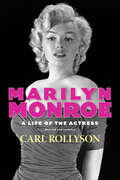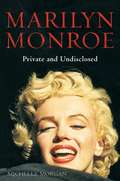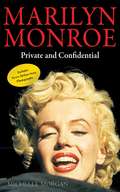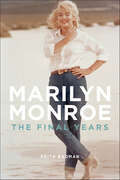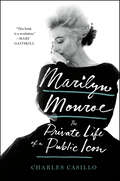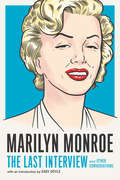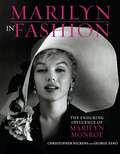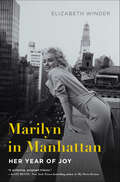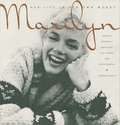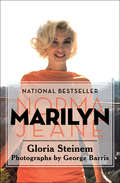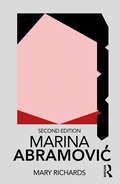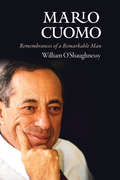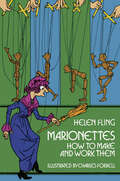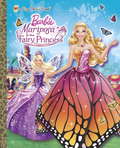- Table View
- List View
Maribel Verdú
by Nuria VidalUn libro sobre Maribel Verdú, una de las estrellas más internacionales de nuestro cine e icono generacional. Aunque resulte difícil de creer, Maribel Verdú ha cumplido veinticinco años en el cine. En este tiempo ha rodado más de sesenta películas a las órdenes de los directores más prestigiosos dentro y fuera de España, en papeles por los que ha recibido un sinfín de premios y que no dejan lugar a dudas sobre la talla de esta extraordinaria actriz, joven, guapa y protagonista de alguna de las secuencias más sensuales de la historia del cine español. Una mujer de su tiempo y con una personalidad arrolladora que trasciende la gran pantalla por su naturalidad, su simpatía desbordante, el compromiso sin límites con su trabajo y un entusiasmo que la lleva a colaborar con directores noveles y en películas de escaso presupuesto siempre que haya un papel que merezca la pena. Con el desenfado y la gracia que la caracterizan, nos habla sin reparos de éxitos y fracasos, de sus amigos, de las ciudades que ama o de las malas experiencias. Confiesa que le desagrada madrugar, que adora el orden y que le encanta salir a comer fuera porque no le gusta cocinar, o que su casa está llena de libros y pingüinos. Descubrimos a la Maribel más íntima, la que se muestra tal y como es, sin miedo a decir lo que piensa. En definitiva, una vida que resume la de toda una generación de mujeres que crecieron como ella en un país que empezaba a disfrutar de una libertad recién adquirida. Una mujer con mucho futuro por delante, gracias a esa buena estrella que nunca la abandona.
Marie, Dancing
by Carolyn Meyerfrom the book jacket: the music soars. the curtain lifts. Marie van Goethem rises onto her toes and floats across the stage of the Paris Opera. And in that moment, fourteen-year-old Marie is happy. Unfortunately, that's almost the only joy in Marie's life. When she's not dancing, she is tormented by hunger, overwhelmed by her mother's uncontrolled drinking, and angered by her older sister's chronic selfishness. However, when Edgar Degas demands Marie's presence in his studio, it appears that her life will he transformed. Each week as she poses for the famous artist, Marie dreams-of a life without poverty, of being with her one true love, and of becoming a star of the ballet. But can being Monsieur Degas's model bring her all that she imagines? Here is the story of the girl immortalized in Degas's most famous sculpture, Little Dancer Aged Fourteen. It's a heartbreaking tale of passion for ballet, of loyalty to family, and of enduring love.
Marilyn
by Gloria SteinemIn this sensitive, provocative portrait of Marilyn Monroe, Gloria Steinem reveals the woman behind the myth--the child Norma Jean--and the forces in America that shaped her into the fantasy and icon that has never died.
Marilyn & Me
by Lawrence SchillerAn intimate memoir recalling a young photographer's relationship with Marilyn Monroe just months before her death, with extraordinary photographs, some of which have never been published."With the precision of a surgeon, Schiller slices through the façade of Marilyn Monroe in his unflinching memoir. Revealing and readable, it's a book I couldn't put down." --Tina BrownWhen he pulled his station wagon into the 20th Century-Fox studios parking lot in Los Angeles in 1960, twenty-three-year-old Lawrence Schiller kept telling himself that this was just another assignment, just another pretty girl. But the assignment and the girl were anything but ordinary. Schiller was a photographer for Look magazine and his subject was Marilyn Monroe, America's sweetheart and sex symbol. In this intimate memoir, Schiller recalls the friendship that developed between him and Monroe while he photographed her in Hollywood in 1960 and 1962 on the sets of Let's Make Love and the unfinished feature Something's Got to Give, the last film she worked on. Schiller recalls Marilyn as tough and determined, enormously insecure as an actress but totally self-assured as a photographer's model. Monroe knew how to use her looks and sexuality to generate publicity, and in 1962 she allowed Schiller to publish the first nude photographs of her in over ten years, which she then used as a weapon against a studio that wanted to have her fired--and ultimately succeeded. The Marilyn Schiller knew and writes about was adept at hiding deep psychological scars, but she was also warm and open, candid and disarming, a movie star who wished to be taken more seriously than she was. Accompanying the text are eighteen of the author's own photographs, some never previously published. Many writers have tried to capture her essence on the page, but as someone who was in the room, a young man Marilyn could connect with and trust, Schiller gives us a unique look at the real woman offscreen."In this short, splendid memoir, Lawrence Schiller offers us another cut on the scintillating diamond that is Marilyn Monroe. In clear honest straightforward prose, Schiller allows us to dwell in the heart of another time. He captures Marilyn, both in photographs and words, and in so doing he gives us intimate access into one of the great stories of the 20th century: the complicated cocktail of joy and sadness that goes along with both beauty and fame." --Colum McCannFrom the Hardcover edition.
Marilyn Monroe
by Barbara LeamingBarbara Leaming's Marilyn Monroe is a complex, sympathetic portrait that will forever change the way we view the most enduring icon of America sexuality. To those who think they have heard all there is to hear about Marilyn Monroe, think again. Leaming's book tells a brand-new tale of sexual, psychological, and political intrigue of the highest order. Told for the first time in all its complexity, this is a compelling portrait of a woman at the center of a drama with immensely high stakes, a drama in which the other players are some of the most fascinating characters from the worlds of movies, theater, and politics. It is a book that shines a bright light on one of the most tumultuous, frightening, and exciting periods in American culture. Basing her research on new interviews and on thousands of primary documents--including revealing letters by Arthur Miller, Elia Kazan, John Huston, Laurence Olivier, Tennessee Williams, Darryl Zanuck, Marilyn's psychiatrist Dr. Ralph Greenson, and many others--Leaming has reconstructed the tangle of betrayal in Marilyn's life. For the first time, a master storyteller has put together all of the pieces and told Marilyn's story with the intensity and drama it so richly deserves. At the heart of this book is a sexual triangle and a riveting story that has never been told before. You will come away filled with new respect for Marilyn's incredible courage, dignity, and loyalty, and an overwhelming sense of tragedy after witnessing Marilyn, powerless to overcome her demons, move inexorably to her own final, terrible betrayal of herself. Marilyn Monroe is a book that will make you think--and will break your heart.
Marilyn Monroe
by Barbara LeamingBarbara Leaming's Marilyn Monroe is a complex, sympathetic portrait that will totally change the way we view the most enduring icon of American sexuality. To those who think they have heard all there is to hear about Marilyn Monroe, think again. Leaming's book tells a brand-new tale of sexual, psychological, and political intrigue of the highest order. Told for the first time in all its complexity, this is a compelling portrait of a woman at the center of a drama with immensely high stakes, a drama in which the other players are some of the most fascinating characters from the world's of movies, theater, and politics. It is a book that shines a bright light on one of the most tumultuous, frightening, and exciting periods in American culture. Basing her research on new interviews and on thousands of primary documents, including revealing letters by Arthur Miller, Elia Kazan, John Huston, Laurence Olivier, Tennessee Williams, Darryl Zanuck, Marilyn's psychiatrist Dr. Ralph Greenson, and many others, Leaming has reconstructed the tangles of betrayal in Marilyn's life. For the first time, a master storyteller has put together all of the pieces and told Marilyn's story with the intensity and drama it so richly deserves. At the heart of this book is a sexual triangle and a riveting story of betrayal that has never been told before. You will come away filled with new respect for Marilyn's incredible courage, dignity, and loyalty, and an overwhelming sense of tragedy after witnessing Marilyn, powerless to overcome her demons, move inexorably to her own final, terrible betrayal of herself. Marilyn Monroe is a book that will make you think--and will break your heart.From the Hardcover edition.
Marilyn Monroe y las estrellas de Hollywood
by Nadja Beinert, Claudia BeinertLLEGA A ESPAÑA UNA COLECCIÓN BEST SELLER CON NOMBRE DE MUJER Marilyn Monroe, Audrey Hepburn y Marlene Dietrich dan salida a esta serie de biografías noveladas sobre grandes personajes de la cultura universal.Descubre las vidas de novela que han inspirado a millones de mujeres de la mano de Suma de Letras. En ocasiones, las estrellas nacen. Pero también hay que crearlas. Los Ángeles, 1942. Norma Jeane Baker vive una niñez solitaria y se refugia en el cine. Aunque un matrimonio pactado la obliga a abandonar su sueño de convertirse en una estrella, cuando un fotógrafo intenta hacer de ella una modelo famosa Norma cobra vida frente a la cámara y deja atrás todas sus inseguridades. No tarda en darse cuenta de que su lugar está bajo los focos; que solo bajo su luz puede ser feliz. Pero, para lograrlo, primero deberá liberarse de las reglas puritanas de la época para deshacerse de Norma Jeane y convertirse en una mujer única cuyo nombre brillará en el firmamento durante generaciones: Marilyn Monroe. «Nunca he engañado a nadie. He permitido que la gente se engañara a sí misma. No se molestaron en averiguar quién ni qué era yo en realidad».MARILYN MONROE
Marilyn Monroe: A Life of the Actress, Revised and Updated (Hollywood Legends Series)
by Carl RollysonIn American popular culture, Marilyn Monroe(1926–1962) has evolved in stature from movie superstar to American icon. Monroe's own understanding of her place in the American imagination and her effort to perfect her talent as an actress are explored with great sensitivity in Carl Rollyson's engaging narrative. He shows how movies became crucial events in the shaping of Monroe's identity. He regards her enduring gifts as a creative artist, discussing how her smaller roles in The Asphalt Jungle and All About Eve established the context for her career, while in-depth chapters on her more important roles in Bus Stop, Some Like It Hot, and The Misfits provide the centerpiece of his examination of her life and career. Through extensive interviews with many of Monroe's colleagues, close friends, and other biographers, and a careful rethinking of the literature written about her, Rollyson is able to describe her use of Method acting and her studies with Michael Chekhov and Lee Strasberg, head of the Actors' Studio in New York. The author also analyzes several of Monroe's own drawings, diary notes, and letters that have recently become available. With over thirty black-and-white photographs (some published for the first time), a new foreword, and a new afterword, this volume brings Rollyson's 1986 book up to date. From this comprehensive, yet critically measured wealth of material, Rollyson offers a distinctive and insightful portrait of Marilyn Monroe, highlighted by new perspectives that depict the central importance of acting to the authentic aspects of her being.
Marilyn Monroe: New edition: revised and expanded
by Michelle MorganFollowing a number of sensationalist biographies of Marilyn Monroe in recent years, this comprehensive, meticulously researched volume brings an important fresh perspective on the many controversies in her life. It is essential reading for anyone interested in Marilyn Monroe and the Golden Age of Hollywood. This new edition of Marilyn Monroe: Private and Undisclosed has been thoroughly revised and expanded to include an additional 60,000 words. It reveals a very different Marilyn from the celluloid invention. For the first volume, Michelle Morgan interviewed approximately 100 people who knew or were related to Marilyn in some way, including key figures in her life - family and friends, as well as work colleagues, and more casual acquaintances. This new edition includes information gleaned from many more interviews, as well as additional family background and many new stories. Marilyn Monroe: Private and Undisclosed is the most comprehensive Monroe biography yet. It covers her trip to England in great detail and gives the true story behind the making of The Prince and the Showgirl.Praise for the 2007 hardback illustrated edition of Marilyn Monroe, Private and Undisclosed:'A gorgeous collection offering a fascinating insight into Monroe's personal life.' Woman & Home'A touching portrayal of the star in her more private moments.' Empire'This candid and often surprising study of the screen legend provides another view of her.' Red
Marilyn Monroe: Private and Confidential
by Michelle MorganFor the first time in paperback, this valuable biography by the president of Marilyn Monroe's UK fan club contains the most comprehensive collection of primary source material on Marilyn Monroe, covering all stages of her life. It includes seventy rare and unpublished photographs. They include locations from various periods of her life-the schools she attended as Norma Jeane, the ballroom where she danced with first husband Jim Dougherty, the street where Marilyn claimed she was attacked by an intruder, and candid shots of her on the sets of films. Morgan has also interviewed every single person accessible who knew or was related to Marilyn in any way, including the main players in her life, as well as work colleagues, and more casual acquaintances. More than fifty interviewees are featured, many who've never gone on the record before, including contacts from her orphaned childhood and early years-details of which until now have remained mysterious. Documentary sources range from the private testimony of her gynecologist, to the previously undisclosed Laurence Olivier papers relating to Marilyn's time in England. Following a series of sensationalist biographies of Marilyn Monroe in recent years, this comprehensive, meticulously researched volume brings an important, fresh perspective to the many controversies in her life, and will serve as an essential sourcebook of documentary and photographic evidence.
Marilyn Monroe: The Final Years
by Keith BadmanPublished for the fiftieth anniversary of her tragic death, this definitive account dispels the rumors and sets the record straight on her last two yearsMarilyn Monroe passed away at the age of thirty-six under circumstances that have remained mysterious to this day. Marilyn Monroe: The Final Years separates the myths and rumors from the facts as Keith Badman takes readers through the concluding months of 1960 to that fateful day in August 1962. In this extraordinary book—the product of five years of exhaustive research—the author is both biographer and detective: Badman uncovers long-lost or previously unseen personal records, exclusive interviews, and eyewitness accounts that illuminate the final chapter of Marilyn's life as she navigates weight gain, drug use, an dpersonal turmoil, along with drama on the set of the ill-fated movie Something's Got to Give. Badman dispels popular beliefs, such as her supposed affairs with John and Bobby Kennedy. (Monroe only had a one-night stand with the president at Bing Crosby's house, and never with Bobby.) Readers learn the long-concealed identity of her biological father, who refused Marilyn's attempt to contact him in 1951—and was then repaid with her apathy ten years later when he attempted to contact her. The author also reveals the details of her famous "last Sitting" with photographer Bert Stern (which was not her last photo shoot) and describes the horror she endured after being tricked into being institutionalized at the Payne-Whitney Psychiatric Clinic, from which ex-husband Joe DiMaggio had to pull strings to secure her release. Perhaps most shockingly, we learn of the regrettable incident in which a drunken Monroe was sexually exploited by mobsters at a Lake Tahoe hotel co-owned by Frank Sinatra. Finally contrary to the salacious rumors that Marilyn was suicidal or the victim of a murder and cover-up, Badman discloses new information about her final days alive and reveals, in unequivocal detail, evidence that indicates Monroe's death was accidental. Above it all, Badman pays homage to Monroe by rescuing her final months from the realm of wild and sensationalized allegations popularized by those who sought to gain from them. Marilyn Monroe: The Final Years sheds new light on an immortal movie legend.
Marilyn Monroe: The Private Life of a Public Icon
by Charles CasilloBased on new interviews and research, this ground-breaking biography explores the secret selves behind Marilyn Monroe’s public facades.Marilyn Monroe: her beauty still captivates, her love life still fascinates, and her story still dominates popular culture. Now, drawing on years of research and dozens of new interviews, this biography cuts through decades of lies and secrets and introduces you to the Marilyn Monroe you always wanted to know: a living, breathing, complex woman, bewitching and maddening, brilliant yet flawed.Explored through the lens of new interviews and meticulous research, Marilyn Monroe unveils Marilyn's story against the backdrop of pre-feminist times. Experience her journey from a distressing childhood to the pedestal of stardom, eloquently explaining her pursuit of ambition in face of a continuous struggle with bipolar disorder. Each phase of her life, marked by celebrated love affairs and heartrending tragedies, is a stepping stone towards immortality.The tell-all narrative includes eye-opening revelations, from the concealed compassionate act of Elizabeth Taylor towards Marilyn to her lost semi-nude love scene with Clark Gable, chronicling the few nights before her death with Warren Beatty, where she divulges her despair during their fateful encounter.This biography also provides a comprehensive account of her final days, meticulously examining the series of miscommunications and misjudgments contributing to her calamitous end. Embark on this enlightening journey of the life and legacy of Marilyn Monroe.
Marilyn Monroe: and Other Conversations (The Last Interview Series)
by Melville House"I'm so many people. They shock me sometimes. I wish I was just me!" --Marilyn MonroeNearly sixty years after her death, Marilyn Monroe remains an icon whom everyone loves but no one really knows. The conversations gathered here--spanning her emergence on the Hollywood scene to just days before her death at age 36--show Monroe at her sharpest and most insightful on the thorny topics of ambition, fame, femininity, desire, and more. Together with an introduction by Sady Doyle, these pieces reveal yet another Marilyn: not the tragic heroine she's become in the popular imagination, but a righteously and justifiably angry figure breaking free of the limitations the world forced on her.
Marilyn Monroe: revised and expanded
by Michelle MorganFollowing a number of sensationalist biographies of Marilyn Monroe in recent years, this comprehensive, meticulously researched volume brings an important fresh perspective on the many controversies in her life. It is essential reading for anyone interested in Marilyn Monroe and the Golden Age of Hollywood. This new edition of Marilyn Monroe: Private and Undisclosed has been thoroughly revised and expanded to include an additional 60,000 words. It reveals a very different Marilyn from the celluloid invention. For the first volume, Michelle Morgan interviewed approximately 100 people who knew or were related to Marilyn in some way, including key figures in her life - family and friends, as well as work colleagues, and more casual acquaintances. This new edition includes information gleaned from many more interviews, as well as additional family background and many new stories. Marilyn Monroe: Private and Undisclosed is the most comprehensive Monroe biography yet. It covers her trip to England in great detail and gives the true story behind the making of The Prince and the Showgirl.Praise for the 2007 hardback illustrated edition of Marilyn Monroe, Private and Undisclosed:'A gorgeous collection offering a fascinating insight into Monroe's personal life.' Woman & Home'A touching portrayal of the star in her more private moments.' Empire'This candid and often surprising study of the screen legend provides another view of her.' Red
Marilyn in Fashion: The Enduring Influence of Marilyn Monroe
by Christopher Nickens George ZenoFifty years after her death, Marilyn remains an incandescent movie star, legendary sex symbol, and a woman whose private life fascinates the public--but the story never before showcased is Marilyn Monroe's enduring impact on fashion. <P><P>From the pink satin "Diamonds Are a Girl's Best Friend" gown, to the pleated white dress from The Seven Year Itch to the revealing nude sheath worn to sing "Happy Birthday" to JFK, Marilyn created endless unforgettable looks. Before they were household names, she wore Ferragamo pumps, carried Gucci bags and wore the designs of Oleg Cassini, Norman Norell, Emilio Pucci and Jean Louis. In an era of Peter Pan collars, poodle skirts, and repressed sexuality, Marilyn's sexy style and ability to spot up-and-coming designers made her a fashion visionary. Marilyn in Fashion traces the evolution of her style, from wholesome sweetness early in her career, to sex kitten looks in the '50s, to elegant sophistication in the last years of her life. The text details the designers of her ensembles, where she wore them, and their influence on fashion. Behind-the-scenes stories reveal how the star often worked closely with designers to create looks befitting the Marilyn Monroe image. Illustrated with hundreds of rare and never-before-published photos, Marilyn in Fashion fabulously traces the style evolution of the ultimate Hollywood icon.
Marilyn in Manhattan: Her Year of Joy
by Elizabeth WinderA city, a movie star, and one magical year.In November of 1954 a young woman dressed plainly in a white oxford, dark sunglasses and a black pageboy wig boards a midnight flight from Los Angeles to New York. As the plane’s engines rev she breathes a sigh of relief, lights a cigarette and slips off her wig revealing a tangle of fluffy blonde curls. Marilyn Monroe was leaving Hollywood behind, and along with it a failed marriage and a frustrating career. She needed a break from the scrutiny and insanity of LA. She needed Manhattan. In Manhattan, the most famous woman in the world can wander the streets unbothered, spend hours at the Met getting lost in art, and afternoons buried in the stacks of the Strand. Marilyn begins to live a life of the mind in New York; she dates Arthur Miller, dances with Truman Capote and drinks with Carson McCullers. Even though she had never lived there before, in New York, Marilyn is home.In Marilyn in Manhattan, the iconic blonde bombshell is not only happy, but successful. She breaks her contract with Fox Studios to form her own production company, a groundbreaking move that makes her the highest paid actress in history and revolutionizes the entertainment industry. A true love letter to Marilyn, and a joyous portrait of a city bursting with life and art, Marilyn in Manhattan is a beautifully written, lively look at two American treasures: New York and Marilyn Monroe, and sheds new light on one of our most enduring icons.
Marilyn: A Biography
by Norman MailerBiography about the iconic figure and movie star, Marilyn Monroe.
Marilyn: Her Life In Her Own Words
by George BarrisYou Are The First One I'm Telling This To. I'll Tell You All. . . No one looked like her. No one walked like her. No one talked like her. Sexy yet vulnerable, and unexpectedly talented, she was no ordinary screen goddess. Few really knew her. What others wrote, she called Lies! Lies! Lies! Here, at last, is Marilyn Monroe's account, in her own singular voice. It was June 1, 1962, her thirty-sixth birthday. Famed photographer and reporter George Barris had come to see Marilyn on the set of what would be her final, unfinished, film. They had met eight years earlier, became friends, and planned to do a picture book and autobiography. Now the time was right. For the next six weeks Barris photographed and interviewed the actress. Don't believe anything you read about me except this. . . she told Barris. And so she began to confide the truth about herself. Barris last talked to Marilyn on August 3, less than twenty-four hours before she was found dead in her apartment. At their last meeting, she was effervescent and eager to embrace life. I feel I'm just getting started, she said. Barris firmly believes that murder, not suicide, caused Marilyn's untimely end and he could not bring himself to publish her thoughts or the haunting photos of that summer--until now. Marilyn: Her Life In Her Own Words is a candid memoir enhanced by 150 black-and-white and color photos, many never before published. A highlight is The Last Photo Shoot where Marilyn appears luminous without makeup on the beach at Santa Monica and in a North Hollywood house. This moving book brings Marilyn Monroe back--beautiful, flirtatious, and sweet as a first kiss--for one rare and radiant farewell. George Barris has worked as a photojournalist for many of the country's major magazines, from Life to Cosmopolitan. He is the co-author (with Gloria Steinem) of Marilyn-Norma Jean, and contributed to Norman Mailer's book, Marilyn. He lives in California.
Marilyn: Norma Jeane
by Gloria SteinemThe feminist icon and New York Times–bestselling author offers an intimate appraisal of the ultimate sex symbol—and the real woman behind the images. Few books have altered the perception of a celebrity as much as Marilyn. Gloria Steinem, the renowned feminist who inspired the film The Glorias, reveals that behind the familiar sex symbol lay a tortured spirit with powerful charisma, intelligence, and complexity. This national bestseller delves into a topic many other writers have ignored—that of Norma Jeane, the young girl who grew up with an unstable mother, constant shuffling between foster homes, and abuse. Steinem evocatively recreates that world, connecting it to the fragile adult persona of Marilyn Monroe. Her compelling text draws on a long, private interview Monroe gave to photographer George Barris, part of an intended joint project begun during Monroe&’s last summer. Steinem&’s Marilyn also includes Barris&’s extraordinary portraits of Monroe, taken just weeks before the star&’s death. &“An even-handed introduction to the Monroe phenomenon.&” —Library Journal
Marilyn: Norma Jeane
by Gloria SteinemThe feminist icon and New York Times–bestselling author offers an intimate appraisal of the ultimate sex symbol—and the real woman behind the images. Few books have altered the perception of a celebrity as much as Marilyn. Gloria Steinem, the renowned feminist who inspired the film The Glorias, reveals that behind the familiar sex symbol lay a tortured spirit with powerful charisma, intelligence, and complexity. This national bestseller delves into a topic many other writers have ignored—that of Norma Jeane, the young girl who grew up with an unstable mother, constant shuffling between foster homes, and abuse. Steinem evocatively recreates that world, connecting it to the fragile adult persona of Marilyn Monroe. Her compelling text draws on a long, private interview Monroe gave to photographer George Barris, part of an intended joint project begun during Monroe&’s last summer. Steinem&’s Marilyn also includes Barris&’s extraordinary portraits of Monroe, taken just weeks before the star&’s death. &“An even-handed introduction to the Monroe phenomenon.&” —Library Journal
Marina Abramović (Routledge Performance Practitioners)
by Mary RichardsMarina Abramović is the creator of pioneering performance art which transcends the form’s provocative origins. Her visceral and extreme performances have tested the limits of both body and mind, communicating with audiences worldwide on a personal and political level. Updated and revised throughout, the book combines: a biography, setting out the contexts of Abramović’s work an examination of the artist through her writings, interviews and influences a detailed analysis of her work, including studies of the Rhythm series, Nightsea Crossing and 512 Hours practical explorations of the performances and their origins. As a first step towards critical understanding, and as an initial exploration before going on to further, primary research, Routledge Performance Practitioners offer unbeatable value for today’s student.
Mario Cuomo: Remembrances of a Remarkable Man
by William O'ShaughnessyA personal, behind-the-scenes look at a Democratic iconGovernor Mario Cuomo’s life and accomplishments are part of the public record, but in Mario Cuomo: Remembrances of a Remarkable Man, William O’Shaughnessy gives readers an exclusive and a deeply personal, behind-the-scenes look at the liberal Democratic icon. This poignant memoir, based on the author’s thirty-eight-year friendship with Governor Cuomo, portrays the spiritual journey of a man who played many roles: inspirational political leader, moral compass, spellbinding orator, gifted author, legal scholar, and loving father and grandfather. He was, in O’Shaughnessy’s words, one of the most articulate and graceful public men of the twentieth century.
Marion's Angels (Pennington #4)
by K. M. PeytonMarion's Angels is an unusual novel about a lonely girl and her love for an impressive medieval church on the river marsh near her father's cottage. "That queer little Marion", the villagers would say, "Why would she want a church of her own?" But Marion, in an emotional tangle after her mother's death, didn't care what they thought of her strange fascination. She carefully tended the church and its twelve beautifully carved angels that seemed to her almost alive, praying intensely for the money to save it from ruin. A miracle seems to result from her passionate prayers for her angels. A world famous violinist takes up the cause and arranges a series of benefit performances. Marion is tumbled into a world of concerts and professional musicians--and a confusing web of relationships and connection with the supernatural. In the end crisis, one of Marion's angels seems to save her life--another miracle or just chance? This is a compelling novel for young people, sympathetically portraying a sensitive young girl and her mysterious glimpses of seemingly supernatural coincidences. Peyton, long acknowledged as an outstandingly original writer, tells this story with characteristic warmth and humor, and provides as well interesting insights into the world of professional musicians. It is a story that lingers with the reader long after it has been put down. K. M. Peyton was born in Birmingham, England, and educated at Wimbledon High School, Kingston School of Art and Manchester Art School. It was while an art student that she met her husband, who is a freelance commercial artist. Mrs. Peyton has been writing since she was nine--she had her first book published at fifteen--and when her first daughter was born, she gave up her job as an art teacher to follow a full-time career in writing. Since then she has won several awards, including the Carnegie Medal, and two of her books have been chosen as American Library Association Notable Books. Her celebrated trilogy Flambards has been televised in England.
Marionettes: How to Make and Work Them
by Helen FlingThis is the complete book of marionette craft -- from making heads and constructing bodies to stringing the marionettes on one- and two-hand controls, operating the marionettes, and putting on your own shows. Four books by Helen Fling have been brought together to make this volume. Their wealth of illustrations, tricks, helpful hints and solid, easy-to-follow advice will go far toward making your performances successful, enjoyable, and creative.In the first section, full details are given on making puppet and marionette heads -- creating them, molding them, casting them, making them out of plastic wood and pâpier-maché, painting them, and adding character details such as noses and wigs. The second section tells, in equal detail, how to make hands, feet, legs, arms, and bodies with a variety of methods for joining the parts together, taping, painting, finishing, and placing screw-eyes for mechanical perfection. The third section shows how to construct marionette controls, how to string your marionettes, and how to manipulate your controls for the movements, postures, gestures, and tricks. Costume and character details are also covered. By the end of this section both you and your characters should be ready to perform. The final section covers the details of marionette show production -- building a stage, lighting, scenery, sound effects, curtain-drops, and presentation. One complete play, with full details on stage props, marionettes, and background, is included. More than 400 helpful illustrations show every step of marionette craft from conception and construction to performance.Beginners will find this book to contain everything they need to know to construct marionettes and present their own shows. Puppeteers will find the chapter on head-making equally suited to their craft. Those who have some experience with marionettes will find the sections on tricks, alternate procedures, and professional methods to greatly increase their abilities to build marionettes and create a variety of new effects and successful marionette performances.
Mariposa and the Fairy Princess (Barbie)
by Golden Books Kristen L. DepkenGirls ages 3-7 will love this beautiful hardcover Big Golden Book based on the latest Barbie movie releasing in fall 2013 on DVD and Blu-ray.
